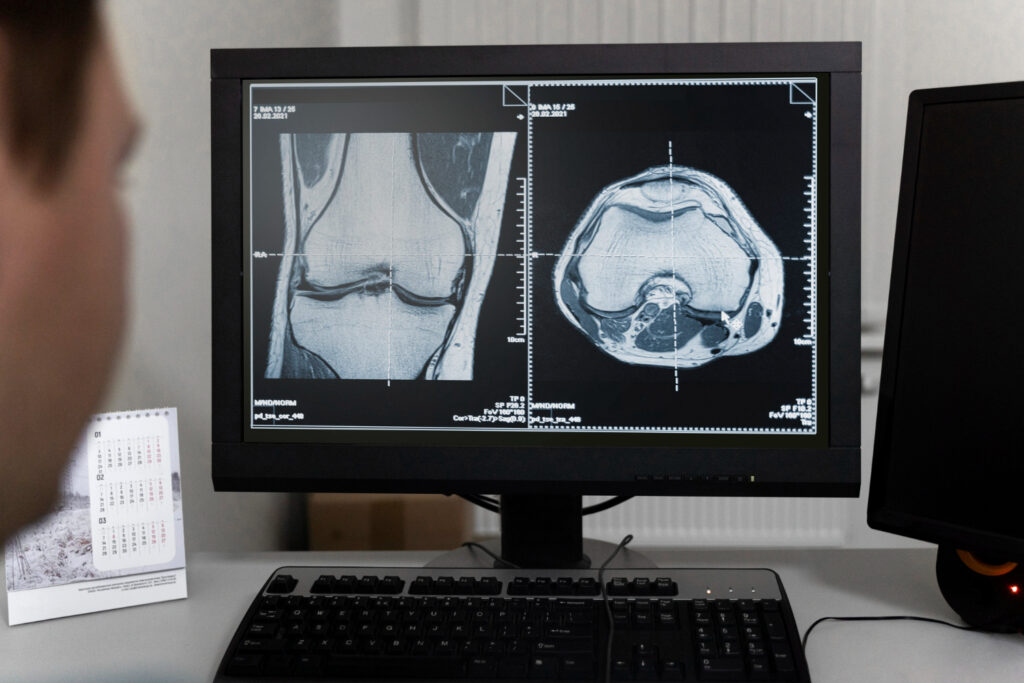Best Sonography Centre in Pune

Doctors Timing
Morning: 9.30 AM To 2.00 PM Evening: 5.30 PM To 9.00 PM
Why QTest for Sonography?
- Government ICMR Authorised Centre
- Lady Radiologist to perform the test
- Same-Day Reporting.
- Pregnancy Sonography
- Anomaly scan
- Soft Tissue Sonography
Why is an Anomaly Scan Important?
The anomaly scan is a vital part of prenatal care, as it helps detect:
Congenital abnormalities like heart defects, neural tube defects, or limb deformities
Growth and development of the baby
Placenta position, ensuring there are no complications like placenta Previa
Amniotic fluid levels, which can indicate potential pregnancy issues
Multiple pregnancies, confirming if there are twins or more
Procedure of Anomaly Scan
During the scan, a sonographer applies gel on the mother’s abdomen and uses a transducer to capture detailed images of the baby. The process is painless and typically takes 20-30 minutes. The doctor examines vital fetal organs, including the brain, heart, spine, kidneys, and limbs.


Abdominal Pelvic Region & Health
Abdominal Pelvic & Its Importance
The abdominal pelvic region houses vital organs like the stomach, intestines, liver, kidneys, bladder, and reproductive structures. Issues here can cause pain or serious conditions.
Common Conditions:
- Digestive Issues – IBS, gastritis, acid reflux
- UTIs & Kidney Stones – Infections, urinary problems
- Reproductive Concerns – Ovarian cysts, fibroids
- Hernias – Organ protrusion
Diagnosis: Ultrasound, CT, MRI, X-ray, blood & urine tests.
Early Detection is Key! If you have persistent pain or discomfort, seek medical advice.
Why is an pregnancy scan Important?
Pregnancy Scan & Its Importance
A pregnancy scan monitors fetal development and maternal health, ensuring a safe pregnancy. It helps detect abnormalities, confirm gestational age, and assess the baby’s position.
Types of Pregnancy Scans:
- Early Pregnancy Scan – Confirms pregnancy, checks heartbeat
- NT Scan – Screens for chromosomal abnormalities
- Anomaly Scan – Examines fetal growth and organ development
- Growth Scan – Assesses baby’s size and placenta function
- Doppler Scan – Evaluates blood flow to the fetus
Diagnosis: Ultrasound (2D, 3D) Doppler imaging.
Regular Scans are Essential! Consult your doctor for timely screenings and a healthy pregnancy.

Frequently Asked Questions (FAQs)
This ultrasound is usually done in the first trimester, between 6 and 10 weeks of pregnancy, to help date your pregnancy, and estimate your baby’s due date. It can also confirm how many babies you are carrying, check that your baby is growing well in your womb, and is not ectopic (outside the uterus).
This is a special ultrasound technique that assesses the movement of materials, like blood, in your body. It allows your provider to see and evaluate blood flow through arteries and veins in your body. Doppler ultrasound is often used as part of a diagnostic ultrasound study or as part of a vascular ultrasound.
- Abnormal growths, such as tumors or cancer.
- Blood clots.
- Enlarged spleen.
- Ectopic pregnancy (when a fertilized egg implants outside of your uterus).
- Gallstones.
- Aortic aneurysm.
- Kidney or bladder stones.
- Cholecystitis (gallbladder inflammation).
- Varicocele (enlarged veins in the testicles).
Best Sonography Centre in Pune
Why Q Test for Sonography
- Government ICMR Authorised Centre
- Lady Radiologist to perform the test
- Same-Day Reporting.
- Pregnancy Sonography
- Anomaly scan
- 4D Sonography
- Soft Tissue Sonography
Frequently Asked Questions (FAQs)
Diagnostic ultrasound, also called sonography or diagnostic medical sonography, is an imaging method that uses high-frequency sound waves to produce images of structures within your body. The images can provide valuable information for diagnosing and treating a variety of diseases and conditions.
Preparations for ultrasound sonography test Abdomen & pelvis. It is important to drink a lot of water before the test since the body must absorb the water..
A fetal ultrasound is an imaging technique that uses sound waves to produce images of a fetus in the uterus. Fetal ultrasound images can help your health care provider evaluate your baby’s growth and development and monitor your pregnancy
This ultrasound is usually done in the first trimester, between 6 and 10 weeks of pregnancy, to help date your pregnancy, and estimate your baby’s due date. It can also confirm how many babies you are carrying, check that your baby is growing well in your womb, and is not ectopic (outside the uterus).
An ultrasound probe moves across the skin of your midsection (belly) area. Abdominal ultrasound can diagnose many causes of abdominal pain.
Providers use kidney ultrasound to assess the size, location and shape of your kidneys and related structures, such as your ureters and bladder. Ultrasound can detect cysts, tumors, obstructions or infections within or around your kidneys.
A breast ultrasound is a noninvasive test to identify breast lumps and cysts. Your provider may recommend an ultrasound after an abnormal mammogram.
This is a special ultrasound technique that assesses the movement of materials, like blood, in your body. It allows your provider to see and evaluate blood flow through arteries and veins in your body. Doppler ultrasound is often used as part of a diagnostic ultrasound study or as part of a vascular ultrasound.
Your provider inserts a probe into your vaginal canal. It shows reproductive tissues such as your uterus or ovaries. A transvaginal ultrasound is sometimes called a pelvic ultrasound because it evaluates structures inside your pelvis (hip bones).
Providers use ultrasound to assess your thyroid, a butterfly-shaped endocrine gland in your neck. Providers can measure the size of your thyroid and see if there are nodules or lesions within the gland.
- Abnormal growths, such as tumors or cancer.
- Blood clots.
- Enlarged spleen.
- Ectopic pregnancy (when a fertilized egg implants outside of your uterus).
- Gallstones.
- Aortic aneurysm.
- Kidney or bladder stones.
- Cholecystitis (gallbladder inflammation).
- Varicocele (enlarged veins in the testicles).

SONOGRAPHY @ kHARADI | BIBWEWADI | KONDHWA BUDRUK
Sonography, also known as ultrasound imaging, is a non-invasive and safe diagnostic method that uses high-frequency sound waves to create images of the inside of the body. This technique helps doctors see internal organs, tissues, and structures without needing surgery.
Sonography works on the principle that sound waves reflect when they hit boundaries between tissues of different densities. Some of the sound wave’s energy bounces back to the transducer, while the rest travels further into the tissue. The transducer then detects these reflected waves to form an image of the internal tissue.
This imaging technique is used across various medical fields, including obstetrics and gynecology, cardiology, neurology, gastroenterology, and urology. It helps diagnose numerous conditions, such as fetal abnormalities, heart disease, liver disease, and kidney stones.
A common use of sonography is in prenatal care, where obstetric sonography monitors fetal growth and development and detects any complications. During this procedure, a gel is applied to the mother’s abdomen to facilitate the transmission of sound waves into the uterus. The transducer is then moved over the abdomen to capture images of the fetus.
Sonography is also frequently used to diagnose cardiovascular issues. Echocardiography, a type of sonography, generates images of the heart to assess its structure and function, helping diagnose conditions like heart valve disease, heart failure, and congenital heart defects.
Additionally, sonography aids in medical procedures like biopsies and needle aspirations. Using ultrasound guidance, physicians can precisely target the area to be sampled, reducing complications and improving accuracy.
Overall, sonography is a safe, non-invasive, and painless diagnostic tool that is widely available and can be performed in various healthcare settings, including hospitals, clinics, and doctors’ offices. If you have symptoms that might require diagnostic testing, consult your healthcare provider to see if sonography is a suitable option for you.
.
Other services

